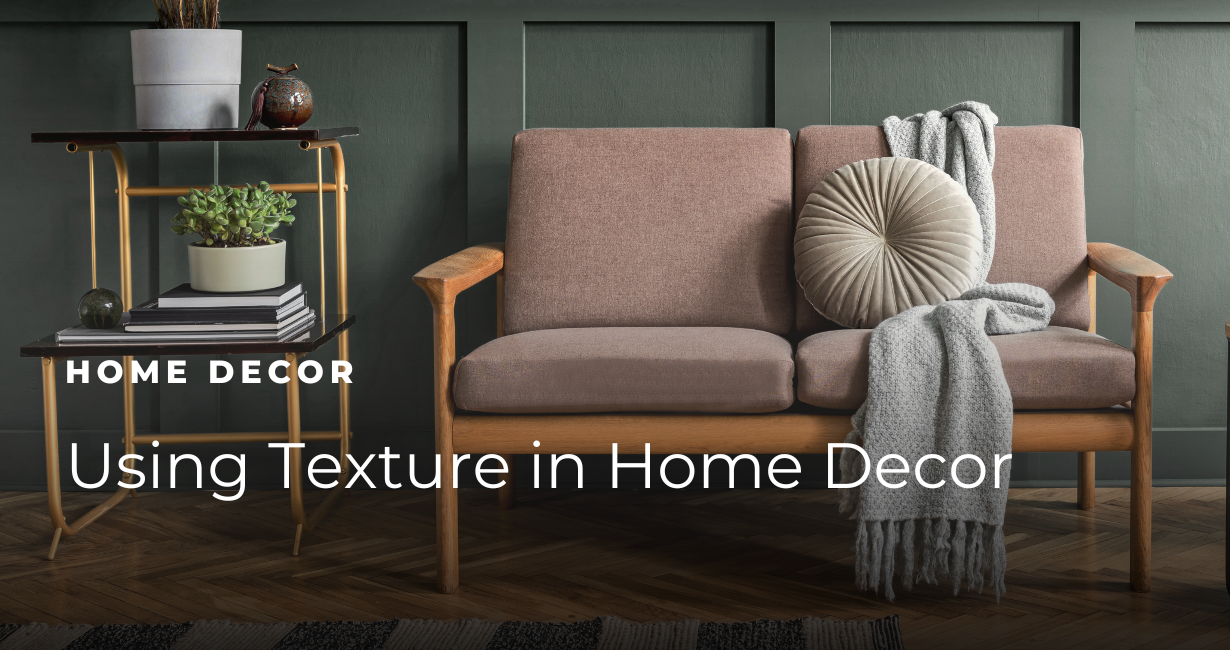Using Texture in Home Decor
Posted by Marketing on Friday, July 14th, 2023 at 11:00am.

When you’re gathering inspiration for your new home, you’re probably thinking about color palettes, scale, and the schools of design that you love. To create a warm and welcoming environment, it’s also important to think about texture.
Texture can refer to the feeling of an object and the way it appeals to your sense of touch, but it can also refer to an object’s physical appearance and impact. Read on as we explore the many ways you can bring texture into your home to create a full sensory experience.
Reach for Textiles
When you’re looking to add texture to a room, a natural place to start is with the textiles that you choose. This includes lush area rugs, soft curtains, and cozy throw blankets and pillows. You can even find lampshades made from interesting textiles like paper, cotton, and burlap.
Another way to incorporate textiles into a room is by hanging or displaying textile art. Macrame and latch hook wall hangings are popular choices that will bring in a touch of vintage whimsy. Woven tapestries and quilts are perfect for creating a focal point on a bare or lackluster wall.
Create Gallery Walls with Mixed Mediums
Gallery walls already create visual texture through the installation of expansive and often asymmetrical arrangements. You can take the texture of your gallery wall one step further by hanging a variety of mediums in different shapes and sizes.
When you’re creating a gallery wall, you have the freedom to play and display just about anything that you can hang on a nail. Great options that introduce new textures include textile art, handmade or recycled paper, metal signs and decals, mirrors, oil paintings with textured brush strokes, and unique wall clocks. Incorporate a few small hanging shelves if you want to display small sculptures and other three-dimensional pieces.
Use a Mix of Modern and Vintage Frames
If you love the idea of a gallery wall but aren’t sold on the mixed-medium approach, there is another way to introduce texture without breaking away from two-dimensional art, prints, and photographs. Put simply: use a mix of modern and vintage frames.
Modern frames are typically minimalist in design, which can help to quiet down busy pieces. Vintage frames, on the other hand, are often on the ornate side, adding intricate details and rich metal finishes to your wall art. You can leave vintage frames in their original state or paint them a bold color for a fresh twist.
Embrace Organic Textures
Perhaps one of the simplest ways to add texture to your interior design is to bring the outside world inside your home. Consider furnishing rooms with pieces made from natural materials, like wood, metal, wool, and cotton. Liven up empty spaces with organic textures like wicker baskets and clay pots.
Houseplants and florals will add both texture and life to any room while freshening your indoor air and giving you the chance to embrace a mindful hobby. Dried florals and high-quality artificial plants can do the trick without the maintenance as long as you’re selecting thoughtful and tasteful pieces. Choose a variety of sizes, growing patterns, and colors for a stunning sensory effect.
Use Three-Dimensional Pieces to Create Vignettes
What can you do with all of your three-dimensional pieces like statuettes, vases, heirlooms, and tchotchkes? Try placing them throughout your home to create vignettes that tell a unique story and put your personal taste on display. Vignettes are perfect for adding texture to coffee tables, bookshelves, and mantles.
There are countless ways to group three-dimensional pieces to create a vignette, whether that’s by color, material, or sentimental value. To ensure visual interest, group items that are different heights and widths; pair objects like tall candlesticks with small figurines. The beauty of a vignette is that it can evolve with you as you incorporate new items into your home over the coming years, and you’re never tied to a single combination or display.
Don’t Forget About Implied Texture
When you’re selecting two-dimensional artwork and prints for your home, you can still add an element of implied texture. Implied texture is created by the layers of a piece’s subject material, rather than the physical materials of the piece. Light and shadow can also create the effect of implied texture in a painting or photograph.
Nature imagery is a great example of implied texture. A photograph of wildflowers will reveal the depth of the field the flowers are growing in as well as the movement and overlap of each petal and leaf. Though you can’t physically feel the texture of the wildflowers, you get a sense of that texture from the visual experience.
The Takeaway
Texture is one of the most important elements of interior design, adding richness, depth, and comfort to any home. There are so many ways that you can intentionally add tactile and visual texture to each room in your Middle Tennessee home, and you’ll notice an immediate difference when you do!







